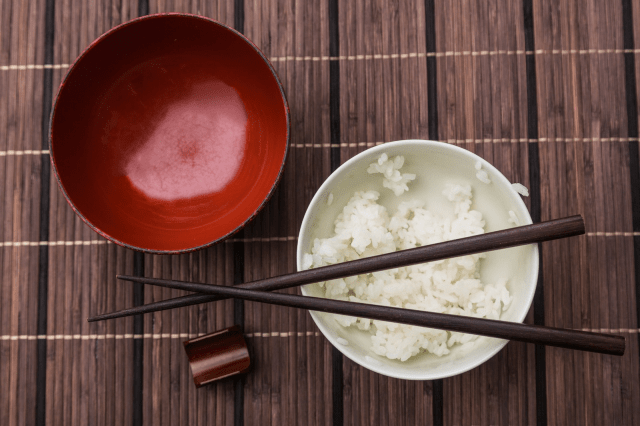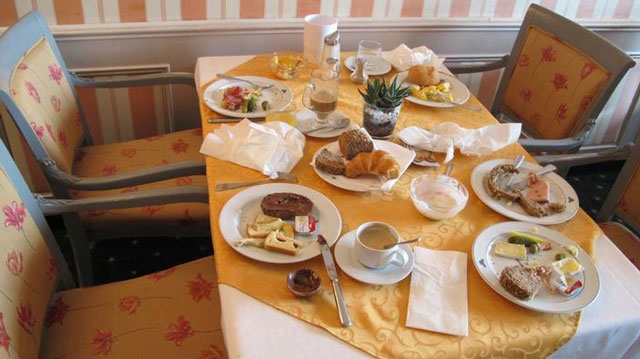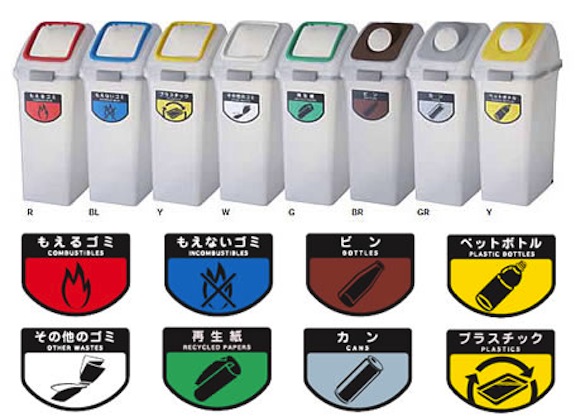In the past few months the Japanese word mottainai, which conveys a sense of regret over waste, has begun to spread into the Western world, and the concept of mottainai can be seen most clearly in every bowl of rice.
waste
As a child, did your parents ever try to get you to finish everything on your plate by telling you how there are starving children in the world who aren’t lucky enough to have the luxury of a decent meal? As a kid, it probably just seemed like an unfair guilt-trip, but as adults hopefully we have all now realized the truth behind those words and the importance of not being wasteful.
A particular Swiss hotel has taken similar tactics to curb the wastefulness of its guests at the breakfast buffet, after shameful amounts of food have been left partially or wholly uneaten and then thrown away. But the hotel took it a step further by including shocking photos to help drive the message home.
Is Japan’s recycling system the most complicated in the world? It sure feels like it sometimes. Household waste must of course be separated into burnable and non-burnable, but after that there’s a dizzying array of recycling categories to break your non-burnables into. Since Japan is a relatively small country without masses of land to use for burying waste, the vast majority of waste used to be incinerated. However, with increasing ecological awareness in the 1990s came new legislation to minimise the amount of waste being burnt, and promote recycling.
Public awareness of the need to recycle is high, but the system can be baffling for new foreign residents. The problem lies not only in the array of recycling categories, but also in the apparent overlap between them: the grey areas. Is an empty pizza box considered recycled paper? Or is it burnable? Paper packages? “Other”? And if a bottle is made of a different type of plastic to the standard PET, is still a “pet bottle”, or is it just “plastic”?
Today we bring you six reasons to learn what goes in what box, and a few hints for getting it right along the way.



 Japan’s oldest largetooth sawfish in captivity back on display in Mie Prefecture
Japan’s oldest largetooth sawfish in captivity back on display in Mie Prefecture Survey finds more than 70 percent of Japanese children have an online friend
Survey finds more than 70 percent of Japanese children have an online friend Yoshinoya adds first-ever chain-wide ramen with new beef and pork-broth noodle hot pot meals
Yoshinoya adds first-ever chain-wide ramen with new beef and pork-broth noodle hot pot meals New Japanese menstrual product seeks to help women spot unidentified iron deficiencies
New Japanese menstrual product seeks to help women spot unidentified iron deficiencies Japan’s otoshidama tradition of giving kids money at New Year’s gets a social welfare upgrade
Japan’s otoshidama tradition of giving kids money at New Year’s gets a social welfare upgrade Doraemon found buried at sea as scene from 1993 anime becomes real life【Photos】
Doraemon found buried at sea as scene from 1993 anime becomes real life【Photos】 Japanese group to hold fashion show of colostomy bags and other stoma equipment in Paris
Japanese group to hold fashion show of colostomy bags and other stoma equipment in Paris We found possibly the quietest Japanese-style hotel in Tokyo’s bustling Shinjuku district
We found possibly the quietest Japanese-style hotel in Tokyo’s bustling Shinjuku district 7-Eleven Japan’s ramen-cooking robot whipped us up a bowl of noodles【Taste test】
7-Eleven Japan’s ramen-cooking robot whipped us up a bowl of noodles【Taste test】 Hayao Miyazaki says Happy New Year to Studio Ghibli fans with new art for Year of the Snake
Hayao Miyazaki says Happy New Year to Studio Ghibli fans with new art for Year of the Snake Starbucks Japan ready to get Year of the Horse started with adorable drinkware and plushies【Pics】
Starbucks Japan ready to get Year of the Horse started with adorable drinkware and plushies【Pics】 Lacquerware supplier to emperor of Japan and Pokémon team up for new tableware
Lacquerware supplier to emperor of Japan and Pokémon team up for new tableware Cyberpunk anime meets traditional culture in Ghost in the Shell gold leaf Japanese changing screens
Cyberpunk anime meets traditional culture in Ghost in the Shell gold leaf Japanese changing screens 7 great places to see Mt. Fuji from without having to climb it
7 great places to see Mt. Fuji from without having to climb it Japan may add Japanese language proficiency, lifestyle classes to permanent foreign resident requirements
Japan may add Japanese language proficiency, lifestyle classes to permanent foreign resident requirements Hello Kitty Choco Egg figures are an adorable trip through three periods of Japanese pop culture【Pics】
Hello Kitty Choco Egg figures are an adorable trip through three periods of Japanese pop culture【Pics】 Starbucks Japan releases new zodiac chilled cup drink for 2026
Starbucks Japan releases new zodiac chilled cup drink for 2026 Can a dirty butthole make you filthy rich in Japan? We’re starting a New Year’s lottery experiment
Can a dirty butthole make you filthy rich in Japan? We’re starting a New Year’s lottery experiment 7-Eleven Japan starts new temporary luggage storage service in over 300 branches
7-Eleven Japan starts new temporary luggage storage service in over 300 branches Disillusionment at Tsukiji’s tourist-target prices led us to a great ramen restaurant in Tokyo
Disillusionment at Tsukiji’s tourist-target prices led us to a great ramen restaurant in Tokyo Starbucks teams up with 166-year-old Kyoto doll maker for Year of the Horse decorations【Photos】
Starbucks teams up with 166-year-old Kyoto doll maker for Year of the Horse decorations【Photos】 Tokyo considering law requiring more trash cans following litter increase in heavily touristed area
Tokyo considering law requiring more trash cans following litter increase in heavily touristed area Tokyo’s Tsukiji sushi neighborhood asks tour groups to stay away for the rest of the month
Tokyo’s Tsukiji sushi neighborhood asks tour groups to stay away for the rest of the month Nintendo’s Kirby now delivering orders at Kura Sushi restaurants, but not in Japan
Nintendo’s Kirby now delivering orders at Kura Sushi restaurants, but not in Japan Tokyo event lets you travel back in time, for free, to celebrate 100 years since Showa era start
Tokyo event lets you travel back in time, for free, to celebrate 100 years since Showa era start Sanrio theme park in Japan announces plans to expand into a Sanrio resort
Sanrio theme park in Japan announces plans to expand into a Sanrio resort Stamina-destroying “Paralysis Noodles” are Tokyo’s newest over-the-top ramen innovation
Stamina-destroying “Paralysis Noodles” are Tokyo’s newest over-the-top ramen innovation Survey asks foreign tourists what bothered them in Japan, more than half gave same answer
Survey asks foreign tourists what bothered them in Japan, more than half gave same answer Japan’s human washing machines will go on sale to general public, demos to be held in Tokyo
Japan’s human washing machines will go on sale to general public, demos to be held in Tokyo Japan’s deadliest food claims more victims, but why do people keep eating it for New Year’s?
Japan’s deadliest food claims more victims, but why do people keep eating it for New Year’s? We deeply regret going into this tunnel on our walk in the mountains of Japan
We deeply regret going into this tunnel on our walk in the mountains of Japan Studio Ghibli releases Kodama forest spirits from Princess Mononoke to light up your home
Studio Ghibli releases Kodama forest spirits from Princess Mononoke to light up your home Major Japanese hotel chain says reservations via overseas booking sites may not be valid
Major Japanese hotel chain says reservations via overseas booking sites may not be valid Put sesame oil in your coffee? Japanese maker says it’s the best way to start your day【Taste test】
Put sesame oil in your coffee? Japanese maker says it’s the best way to start your day【Taste test】 No more using real katana for tourism activities, Japan’s National Police Agency says
No more using real katana for tourism activities, Japan’s National Police Agency says Starbucks Japan reveals new sakura drinkware collection, inspired by evening cherry blossoms
Starbucks Japan reveals new sakura drinkware collection, inspired by evening cherry blossoms Updated cherry blossom forecast shows extra-long sakura season for Japan this year
Updated cherry blossom forecast shows extra-long sakura season for Japan this year Doraemon found buried at sea as scene from 1993 anime becomes real life【Photos】
Doraemon found buried at sea as scene from 1993 anime becomes real life【Photos】 Japanese group to hold fashion show of colostomy bags and other stoma equipment in Paris
Japanese group to hold fashion show of colostomy bags and other stoma equipment in Paris We found possibly the quietest Japanese-style hotel in Tokyo’s bustling Shinjuku district
We found possibly the quietest Japanese-style hotel in Tokyo’s bustling Shinjuku district 7-Eleven Japan’s ramen-cooking robot whipped us up a bowl of noodles【Taste test】
7-Eleven Japan’s ramen-cooking robot whipped us up a bowl of noodles【Taste test】 Hayao Miyazaki says Happy New Year to Studio Ghibli fans with new art for Year of the Snake
Hayao Miyazaki says Happy New Year to Studio Ghibli fans with new art for Year of the Snake A Japanese dating app matched our bachelorette with a Buddhist monk, and she learned some things
A Japanese dating app matched our bachelorette with a Buddhist monk, and she learned some things Spirited Away bath herbs now available at Ghibli exhibition in Japan
Spirited Away bath herbs now available at Ghibli exhibition in Japan More Than a Capsule Stay: Why Solo Travelers Choose “global cabin Yokohama Chinatown”
More Than a Capsule Stay: Why Solo Travelers Choose “global cabin Yokohama Chinatown” Can a dirty butthole make you filthy rich in Japan? We’re starting a New Year’s lottery experiment
Can a dirty butthole make you filthy rich in Japan? We’re starting a New Year’s lottery experiment Japanese ad promoting Miyazaki Prefecture shows how foreign its own dialects can be 【Video】
Japanese ad promoting Miyazaki Prefecture shows how foreign its own dialects can be 【Video】 Crabs take over electric signboard at Japanese train station
Crabs take over electric signboard at Japanese train station Korean fashion trend reveals significance of wearing rings on different fingers
Korean fashion trend reveals significance of wearing rings on different fingers Starbucks Japan ready to get Year of the Horse started with adorable drinkware and plushies【Pics】
Starbucks Japan ready to get Year of the Horse started with adorable drinkware and plushies【Pics】 Meet the eerie police statues of Miyakojima in Okinawa Prefecture
Meet the eerie police statues of Miyakojima in Okinawa Prefecture